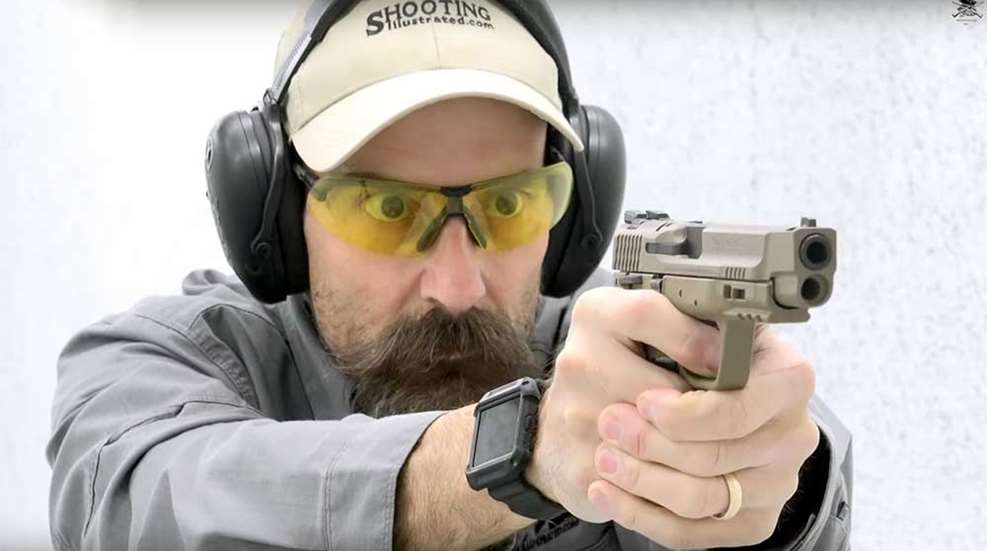Part of my current career is to service federal contracts for three-letter agencies with a vowel to include mission-ready pre-deployment training.
Having built a number of these training packages, there are three fundamental skills that an entry-level shooter must master prior to deployment. Ironically, these are the very same skills that present the very same challenges even to elite performance shooters. Albeit the errors are less frequent and far less egregious, they are essentially the same. What are these critical pre-deployment skills and how do they benefit both the novice and the seasoned professional alike?
First and foremost, immediately following gun safety and gun handling (safely load, unload, reload, holstering, et al) of course, is the ubiquitous trigger press.
One of the foundational skills of the NRA training programs is something called ‘hold control,’ which is holding the gun well enough at the beginning of, and throughout the entire press, including follow-through in such a manner that the muzzle does not fall out of alignment with the intended point of aim.
A typical ‘break drill’ would consist of asking your student to place both hands on the gun, point in to the target, take up any slack on the trigger until they feel the wall and wait for the go signal. On the buzzer or the go command the shooter does absolutely nothing else but execute a perfect trigger press with almost imperceptible, if any, muzzle movement.
More experienced shooters may increase target difficulty with greater distance, a smaller target and/ or less time allotted. Success for the entry level shooter should be readily attainable as success is the best habit-forming training reinforcement tool. More seasoned shooters need to work harder for it.
Second is then aligning the muzzle—say from the holster or in transition from a previous target with the current intended target. Simple a task as it may be, it’s a lot more difficult than we are led to believe.
Presenting the handgun from the holster to perfect muzzle alignment with the target is a developed skill. Aside from the likes of Rob Leatham, none of us normal earth-walkers are born with this skill. It must be initially developed and then further refined.
A drill for the novice would be to have them present from the holster, then using both hands stabilize the muzzle in such a manner that they may be able to then run the previous drill. Demanding a single task (drawing from the holster) attaching it to the next task (finding hold control) and lastly connecting it to the first drill (break drill) is what makes these three steps waypoints to successful performance.
The serious performance shooter is required to execute at a minimal 85-percent success rate at or under a par time. Exponentially more difficult than untimed and of course with greater target difficulty than the novice.
Last but certainly not least, the third and final critical skill is recovery. The continual act of realignment is required whether after a single shot or multiple shots in a succinct and timely manner. Some call this recoil management, other term it recoil control. Call it what you want, but the act of muzzle rise followed by muzzle fall followed be realignment is a tri-part skill coveted by both the novice and seasoned shooter alike.
Recovery is where the wheels often come off, even for shooters with copious rounds down range. The moment the gun recoils, everything the shooter just built—grip, hold, sight alignment, trigger control—must be sustainable without conscious thought. A higher-percentage success rate of that process is what separates a ‘safe shooter’ from a deployable one.
The novice fights to find the shooting process; the professional follows it.
Successful recovery means the muzzle finds its way back to the same visual index every single time, with the shooter already prepared for the next shot before the first one has fully settled.
To build this, novices must isolate the pattern: lift, settle, return. At first it appears mechanical, even exaggerated, but repetition sculpts it into an efficient neural pathway. Once the pattern is reliable, speed develops naturally as a byproduct of efficiency.
For the high-performance shooter, recovery drills become tests of consistency under compression—stringent par times, more technical targets and tighter accuracy requirements. The goal is identical at both ends of the spectrum: to make recovery a subconscious, competent and repeatable cycle that fails to collapse under pressure.
When these three skills—trigger press, muzzle alignment and controlled recovery—are trained separately and then linked together, they help to build the neuropathways required to effectively follow the shooting process.
Whether in pre-deployment workups or elite-level performance shooting, these fundamentals remain the bedrock. They don’t care about rank, resume or reputation. They place a premium demand on efficiency and control. Build them early, refine them over time, and they will carry you through the entire process resulting in success and self-confidence.
Mastery of these pre-deployment skills is more than mechanical proficiency; it forges the quiet voice of self-trust that whispers competency for both the novice and professional alike.
Read the full article here








